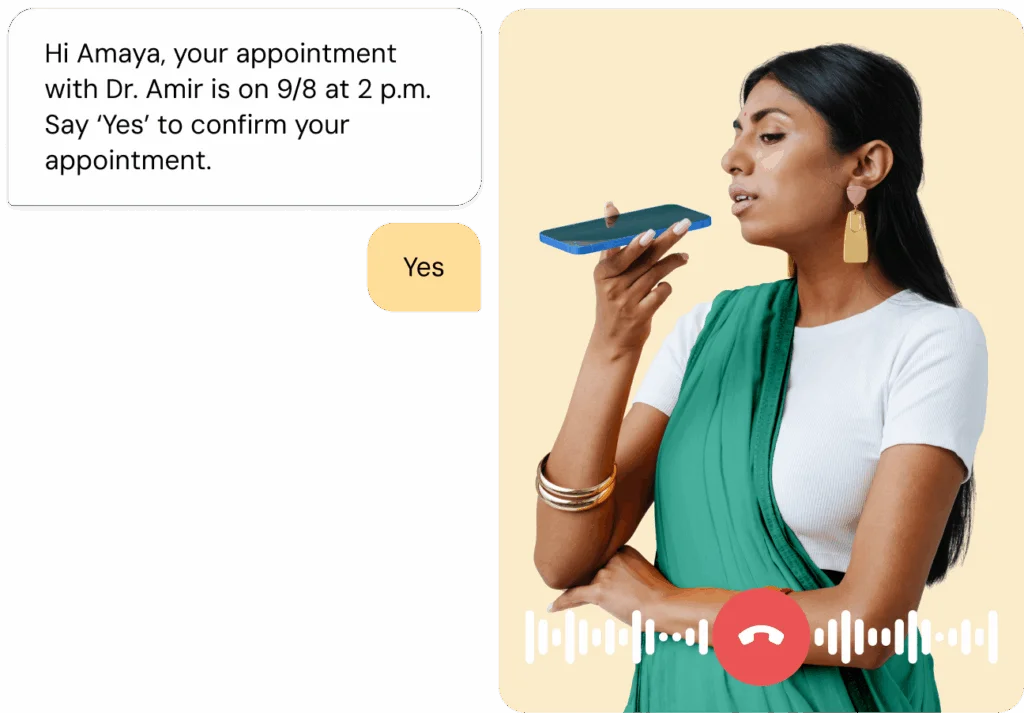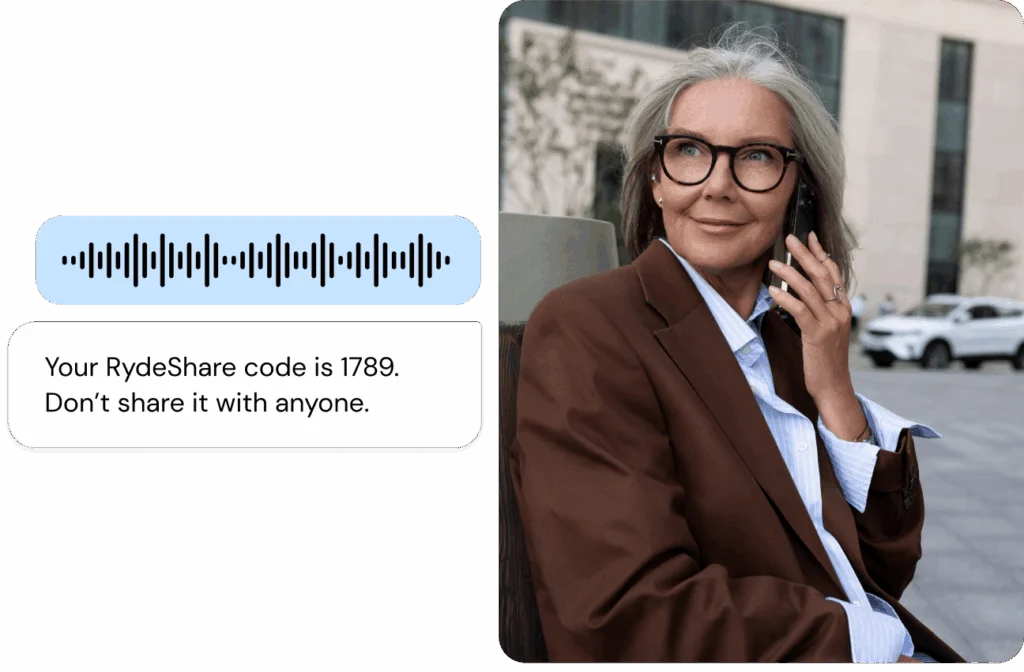Insights
What is voice broadcasting, and how do enterprises use it?

Insights

Reaching thousands of people in minutes requires a channel that cuts through the noise. When every minute counts, phone calls are often noticed long before text messages or emails.
Voice broadcasting – also called voice alerts, voice notifications, voice message broadcasting or automated voice messaging – is a large-scale communication method. It lets enterprises send timely, pre-recorded messages or (automated) text-to-speech calls to thousands of recipients simultaneously.
It can be used for everything from outage notices for customers, appointment reminders for patients, building closure alerts for employees, to time-sensitive safety updates for entire communities.
In this guide, you’ll learn how voice broadcasting works, where it shines, and what to look for in an enterprise solution.
Voice broadcasting is a way to send the same audio message to many recipients’ phones at once. It schedules and delivers calls, collects keypress responses with measurable response rates, and reports results automatically without the need for live agents.
It’s often called “automated broadcasting” because it lets enterprises send pre-recorded messages at scale without manual dialing or agent involvement.
Voice broadcasting is sometimes confused with other calling systems, but here’s how it differs:
Here’s how a typical, smooth deployment works.
The first step is to upload a recording, capture one within the voice platform app, or use text-to-speech (TTS) technology for a clear, consistent voice message. Add brief prompts if you want keypad responses or callback options.
Enhance TTS with AI: AI has evolved to a point where it makes TTS sound very natural reducing the need to record messages in advance and ultimately saving resources.
Choose who you want to receive the voice alert by either manually adding contacts or syncing a list from a database or spreadsheet. It’s best to regularly update your lists to ensure that you reach the right people and don’t call anyone that’s opted out.
Select send windows, throttle rates, and retry logic for busy or no-answer calls, set up rules whether to leave a voicemail if a person doesn’t pick up, or enable answering machine detection to optimize delivery.
When setting up delivery rules, also make sure to upload do-not-call (DNC) lists, so you don’t call users who have opted out. Some systems let you customize the caller ID and use a local number to help boost answer rates.
The voice broadcasting service dials a large number of contacts in parallel using caller ID settings – respecting carrier limits and your schedule – and can branch calls based on answers or keypresses.
After broadcasting, real-time reporting dashboards help you track how each call is going – whether it was answered, missed, or sent to voicemail. Depending on your platform, it’s also possible to use webhooks to instantly trigger the next step in your workflow, like sending a follow-up message or updating your CRM.
Enterprises rely on voice alerts when information must move fast, stay consistent, and reach everyone – no matter where they are. Automation ensures that messages go out instantly and uniformly, even when teams are under pressure or systems are down.
Here’s why voice alerts have become an essential part of enterprise communication:
Voice broadcasting is a fast and reliable way to reach many people at the same time. So let’s look at a few ways enterprises are using voice alerts to get the word out when it really matters.
Customers today expect to be informed immediately when something goes wrong, and they feel safer when they are. Clear, proactive mass communication builds trust and loyalty.
Voice alerts add an immediate layer of reassurance through voice blast technology, ensuring time-sensitive messages aren’t lost in inboxes or ignored on screens.
Unless it’s a case where it’s legally required for your enterprise to send voice alerts to consumers, always ensure that recipients have opted in to receive these notifications.
Here’s how enterprises use them to keep people informed and operations running smoothly.
When emergencies strike, people want immediate, reliable updates. Voice alerts ensure emergency notifications reach call recipients even when power or internet connections are disrupted.
Because calls are harder to miss, they’re ideal for time-sensitive warnings about severe weather, evacuation notices, or safety procedures.
Enterprises can use (AI) TTS or pre-record messages and trigger them automatically to thousands of contacts in seconds across multiple time zones, ensuring consistency under pressure. Getting timely emergency alerts makes people feel safer, which strengthens their trust in the organization’s ability to protect them.
IT disruptions can stall entire operations if communication lags. Automated voice alerts ensure that technical teams, partners, and customers know about outages instantly, without relying on manual calls, emails, or messaging services.
With configurable escalation workflows, alerts can automatically route to on-call engineers or executives when critical thresholds are reached.
Voice automation helps enterprises meet that expectation while preserving compliance and reducing downtime. The result: faster recovery, fewer missed updates, and greater confidence in operational reliability.
Patients value timely reminders, but privacy matters just as much. Nearly half of consumers feel uneasy sharing health information over unsecured channels like email or text.
Automated voice reminders offer a secure, direct, and accessible way to confirm or reschedule appointments, with options for both toll-free number access and voicemail message delivery when patients are unavailable.

With consent-based automation, clinics can deliver consistent, HIPAA-compliant updates without straining administrative staff. The result is fewer missed appointments, better patient adherence, and a more trustworthy communication experience that reinforces the provider’s credibility and care.
Speed is everything when security is at stake. Nearly three out of four consumers say fraud alerts are “very important” and 72% of customers expect these notifications to show up immediately after fraudulent activity is detected.

Because voice calls are immediate and recognizable, financial institutions use them for suspicious activity notifications, credit card freezes, and account verifications through voice broadcast campaigns.
Combining automation with voice gives customers immediate reassurance while helping institutions meet strict security and compliance timelines.
Utility providers face strict expectations during outages and customers want to know what’s happening and when service will be restored. Automated voice alerts let providers proactively reach affected households within minutes, sharing restoration timelines or safety instructions.
Unlike static website updates, a direct call conveys urgency and authenticity, reducing inbound call volume and frustration – especially when integrated with answering machine detection to ensure that messages reach both live recipients and voicemail boxes.
When customers receive consistent, transparent communication during service disruptions, they’re far more likely to view the provider as dependable, even when things go wrong.
Offering customers the options to receive their verification codes via voice alerts makes a great addition to other channels.

Receiving codes through a phone call allows people to access their accounts when they might only have access to a landline or when listening to a code is more convenient or accessible to them.
School closure notifications or sensitive alerts need to reach parents and students promptly.
Automated voice alerts deliver those updates instantly and in an accessible way, so nobody’s left out of the loop. This creates a stronger sense of safety and transparency. They also help educational institutions to keep their messaging consistent.
Plus, with the right tool, you can also deliver them in multiple languages, ensuring nothing gets lost in translation.
When workforces are spread across regions, including those at non-profit organizations focused on fundraising or community outreach, internal communication must be fast and reliable.
Automated voice alerts reach employees directly with updates on shift changes, policy adjustments, or safety protocols, even if messaging apps or email systems are offline. Because these calls are scheduled and tracked automatically, organizations ensure no team is left out of critical updates.
In crisis management scenarios, automation adds consistency when manual communication would be chaotic. Voice alerts also create an auditable record of who received what, supporting compliance and reinforcing a culture of preparedness and trust within large teams.
Voice notifications are also a great way to inform customers about their delivery status. From shipment updates to dispatch notices, voice broadcasts help provide real-time information and keep customers informed.
Sending out voice notices can be a great addition to updates on other channels to improve reach and accessibility.
As with any tool, the results you get out of voice alerts are only as good as its underlying technology. If you’re using an outdated platform or the system isn’t built for scale, voice broadcasts end up feeling more like a painful chore rather than an efficient tool. Here are some areas where many contact centers usually feel that their voice notifications miss the mark.
Depending on the platform you use, high-level output of voice broadcasting calls might be limited. A lot of platforms solve that by having companies throttle their calls through individual requests. While this system works, it takes time to set up these requests and can still create overload. That’s not what you’re looking for when trying to send out thousands of alerts during an emergency.
It doesn’t have to be this way. Some platforms support batch calling. Instead of repeated calling and queueing requests, batch calling lets you make one individual API request to queue all of them – even for a very large number of calls (think: millions of alerts during a weather disaster).
With batch calling, you can also :
This saves time, prevents overload, and there’s no more need to pace or throttle requests.
“You… have… an… appointment… scheduled for… MONDAY… AT… 11… AM.” We all have gotten these chopped and robotic-sounding appointment reminders before. And while they do the job, they don’t sound professional or provide the smoothest voice broadcasting experience.
If that’s something you’re struggling with or want to avoid, look for a voice broadcasting solution that comes with smart text-to-speech features.
AI-based text-to-speech (TTS) can not only automatically generate your voice notifications, they’ll also sound natural and human. And you can easily set up individualized messages with a consistent brand voice.
What’s even worse than the robotic voice? A robotic voicemail that cuts off halfway through and doesn’t even deliver the crucial part of the message.
Unfortunately, that’s not uncommon because answering-machine detection tools aren’t always pulling their weight. As a result, you’re delivering at a bad customer experience. Plus, if your message doesn’t go through, you’re looking at scenarios like missed appointments, failed deliveries, or thousands of worried customers calling you back because they’re not sure what your fraud alert notification said.
All of this can be avoided by choosing a voice alert tool with advanced answering-machine detection capabilities. These ensure that your message won’t be cut off – and you can even customize the message (for example: send message number one if someone answers, send message number two if it goes to voicemail).
In critical situations, it’s vital to reach as many people as possible – in a way they’ll understand. Whether that means adapting to regional dialects or sending out calls in various languages: Your voice notification tool should be able to handle that.
Otherwise, you’re looking at missed communications and frustrated end users. At best, that cuts into your ROI, at worst, people in emergency situations won’t have all the information they need to be safe.
Break down the language barriers with Sinch’s smart text-to-speech functionality. It works for 115+ languages and multiple voices and accents, so you can reach global audiences in their language.
At this point, you’re probably thinking, “this all sounds great, and we’d love to have a powerful voice broadcasting tool – but how complicated is all of this to set up?” The answer is: It really isn’t.
Modern voice alerts tools that are built on a programmable voice API can deliver high-quality voice broadcasts that are easy to scale, adaptable to many use cases, sound human – and will cut through the noise.
Plus, you won’t need to invest in costly hardware or external telephony expertise. Programmable solutions like the Sinch Voice API easily plug into your existing systems, give you full control, and access to a robust platform with powerful voice features – including high-performing voice alerts.
By combining automation with intelligent APIs, you can make your voice notifications immediate, wide-reaching, reliable, and secure.
Ready to see how your enterprise can put voice broadcasts into action? Explore Sinch’s Programmable Voice API for callout alerts or contact our team to learn more.
Voice broadcasting offers enterprises fast, large-scale communication without sacrificing accuracy or compliance. It ensures time-critical messages reach thousands of recipients simultaneously in a way people rarely ignore – through a phone call. That helps increase reach, improve accessibility, and really cut through the noise.
Voice broadcasting automates outbound calls without relying on live agents or manual dialing. Unlike IVR systems, which manage inbound calls and menu-based navigation, voice broadcasting refers to outbound calls where companies deliver pre-recorded or text-to-speech messages to thousands of contacts simultaneously. It’s designed for speed, scale, and consistent outreach, rather than two-way human interaction.
Yes. Modern programmable voice APIs allow personalization, for example by using data from CRMs or with AI-based TTS features. You can include details like names, appointment times, or account information in each message. This makes automated broadcasts feel relevant and human, improving engagement while maintaining compliance with privacy and consent regulations.
Enterprise-grade platforms like Sinch use encryption, secure APIs. They ensure their service is ISO 27001 certified and built on a secure, cloud-native foundation.
Yes, when done right. Automated voice alerts are a legal and effective way to share critical information, not spam robocalls. To stay compliant, follow laws like the Telephone Consumer Protection Act (TCPA) in the U.S. and the General Data Protection Regulation (GDPR) in the European Union, which cover consent, call timing, opt-out options, and data handling. Always check local regulations as these might vary from federal ones, and choose tools that support compliance like programmable voice APIs from providers who meet strict data privacy standards.